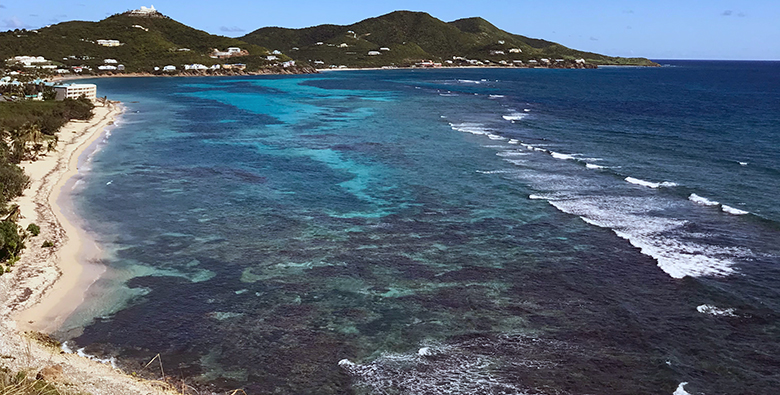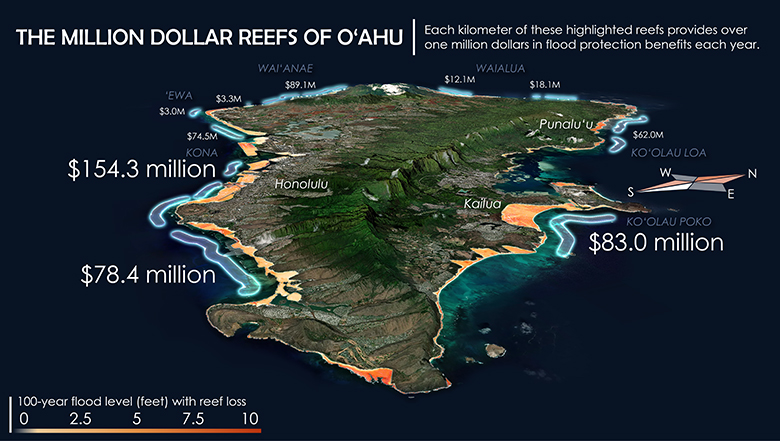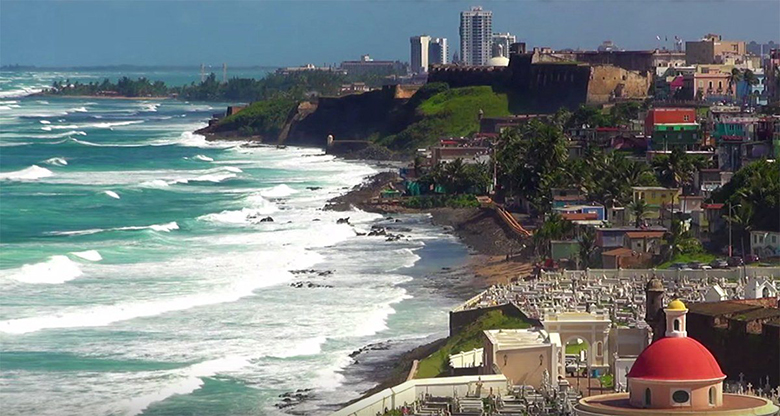- ABOUT US
- PROGRAM AREAS
- CONSERVATION APPROACH
- EDUCATION
- MULTIMEDIA
- FEMA 2023. Infrastructure. https://www.fema.gov/glossary/infrastructure#. Accessed 03/06/2024.
- White House Council on Environmental Quality, White House Office of Science and Technology Policy, White House Domestic Climate Policy Office, 2022. Opportunities for Accelerating Nature-Based Solutions: A Roadmap for Climate Progress, Thriving Nature, Equity, and Prosperity. Report to the National Climate Task Force. Washington, D.C.
- Storlazzi, C.D., Reguero, B.G., Cole, A.D., Lowe, E., Shope, J.B., Gibbs, A.E., Nickel, B.A., McCall, R.T., van Dongeren, A.R., and Beck, M.W., 2019, Rigorously valuing the role of U.S. coral reefs in coastal hazard risk reduction: U.S. Geological Survey Open-File Report 2019–1027, 42 p., https://doi.org/10.3133/ofr20191027.
- Reguero, B.G., Storlazzi, C.D., Gibbs, A.E. et al. The value of US coral reefs for flood risk reduction. Nat Sustain 4, 688–698 (2021). https://doi.org/10.1038/s41893-021-00706-6
- FEMA 2023. FEMA Allocates Millions to Restore Coral Reefs in the Coast of San Juan. Press release, accessed 03/06/2024.
- Coral reefs identified as national natural infrastructure
- Coral Reef Restoration for Risk Reduction (CR4)
- Natural resource restoration by FEMA's Hazard Mitigation Program
- Coral Restoration for Coastal Resilience: A Decision Support Framework
- Pacific Coastal and Marine Science Center
- UCSC Center for Coastal Climate Resilience
Coral Reefs Recognized as National Natural Infrastructure
By: U.S. Coral Reef Task Force National Natural Infrastructure Team
Takeaway: By combining basic scientific research and applied coastal management techniques with policy actions by decision makers, coral reef scientists show that coral reefs are natural infrastructure. This effort was successful because a multidisciplinary team built a solid foundation of science, directly engaged with stakeholders, and committed to novel approaches to coral reef conservation avenues. The culmination of this research and efforts of the U.S. Coral Reef Task Force working group is a national resolution that designates U.S. coral reefs as national, natural infrastructure.

In the past, Infrastructure projects in the US have referred to services and benefits provided to people only by man-made infrastructure such as seawalls, dams, roads, bridges, ports, railways, water systems, and buildings (FEMA 2023). However many of these services and benefits to people such as flood protection and water regulation are provided by nature and nature-based solutions, i.e., by natural infrastructure (White House Council on Environmental Quality, et al, 2022). The term natural infrastructure, also referred to as green infrastructure, refers to naturally occurring landscape features and/or nature-based solutions that promote, use, restore, or emulate natural ecological processes, such as reducing flooding or erosion, while providing other ecological and human benefits. Examples of nature based solutions include restoration of natural habitat like mangroves, and may include projects that combine natural and artificial materials, such as artificial reef bases that support live corals.

Value of coral reefs
About 10 years ago, there was a lack of information on how much coral reefs protected coastal areas from erosion, flooding, and other coastal hazards. A few industrious scientists from the U.S. Geological Survey (USGS), University of California - Santa Cruz (UCSC), and the Nature Conservancy set out to quantify the social and economic value of coral reefs for protecting coastal communities from storm surge and flooding. This involved a lot of math and some complex models. By doing this critical basic research, a solid foundation for coral reefs as natural infrastructure was created.
“Without these basic steps we could not assess the role of coral reefs in reducing wave energy” says Curt Storlazzi, USGS scientist and one of the original partners in this effort. “It was under these efforts when we first made such measurements and, using U.S. Fish and Wildlife Service and Department of Defense funding, massively changed the coastal engineering models — which were not set up for the steep slopes and high hydrodynamic roughness [of coral reefs] — to handle such processes.
The team wanted to know: if we think of reefs as physical structures, as natural breakwaters, how valuable are they for protecting coastal communities from storms, flooding, erosion, and other hazards? What are the economic impacts of degraded coral reefs along our coastlines and how much money would we save if these reefs were restored to their full potential? In a series of studies, USGS and UCSC demonstrated that U.S. coral reefs annually provide flood protection to over 18,000 Americans and $1.8 billion worth of coastal infrastructure (Storlazzi et al. 2019) and that they are particularly important for protecting underserved, underrepresented, and vulnerable populations (Reguero et al. 2021).
Once this work was disseminated to coral reef managers, the team was asked to develop state and regional specific factsheets and maps that would aid managers to communicate this important information to the policymakers in their communities.

First Funding on Coral Reef Restoration for Coastal Protection
The combined impacts of Hurricane Irma and Maria in 2017 motivated the team to apply their initial coral reef hazard risk reduction modeling to assess the impacts of the storms on increasing hazards, and how future degradation due to climate change could make that worse. They also wanted to find out how coral reef restoration could reduce hazards such as flooding due to coastal storms.
This work was presented to the U.S. Coral Reef Task Force in fall 2021 and both the Department of the Interior and NOAA recognized the potential to use this work in acquiring funding for coastal hazard mitigation. The team was then charged to work with the Federal Emergency Management Agency (FEMA) and the U.S. Army Corps of Engineers (USACE)—partners already in the Task Force—to figure out how the states and territories with coral reefs can use the coral reef hazard risk reduction data to get hazard mitigation or disaster recovery funding. The Coral Reef Restoration for Risk Reduction group represented by USGS, UCSC, FEMA, USACE, and NOAA was formed to figure this out.
Coral reef restoration for risk reduction (CR4) projects are different from solely ecological coral restoration projects, in that CR4 projects aim to meet two different management objectives—environmental conservation and hazard mitigation. They often require more specific placement and planning, detailed hydrodynamic analyses, and larger project scales to meet both objectives. The Guide to Coral Reef Restoration for Risk Reduction supports communities seeking funding for projects to reduce flood risks by restoring coral reefs for storm hazard mitigation and climate adaptation.

The recognition by coastal managers and decision makers of the value of coral reef ecosystems for coastal community protection led to further efforts to provide practical guidance on using coral reef restoration in hazard mitigation and to find funding to support these endeavors.
Individual states and territories have declared coral reefs as natural infrastructure critical to the protection of coastal communities. In 2020, the Commonwealth of Puerto Rico declared “coral reefs as an essential structure for the protection of the coasts of Puerto Rico and their inherent relationship in the conservation of beaches and other elements of nature”. In 2023, the State of Hawai’i and Territory of the U.S. Virgin Islands designated coral reefs as natural infrastructure and acknowledged the importance of nature-based solutions to address climate change impacts. Most recently, in March 2024, the government of American Samoa declared coral reefs as critical infrastructure to protect their coasts. The purpose of this recognition is that it allows states and territories to pursue funding and support for coral reef restoration under novel pathways, such as FEMA’s Hazard Mitigation Program.
Also in 2022, the first-ever award for coral reef restoration to protect people after a disaster was issued by FEMA's Hazard Mitigation Program (FEMA 2023). Just over $3 million was allocated for the first phase, out of $38.6 million for the overall initiative. The barrier coral reef system offshore of San Juan coastal communities is the focus of the work, with the structures being a mix of artificial reef substrate and living coral that work together to protect the shoreline. Additionally, three artificial reefs will be placed nearshore to reduce rough surf and dangerous currents around the public beach areas have caused drownings in the past.
Designating Coral Reefs as National Natural Infrastructure
In 2022, the U.S. Coral Reef Task Force (USCRTF) adopted the guidelines for Coral Reefs Restoration for Risk Reduction , and tasked the CR4 team to draft a resolution identifying coral reefs as national, natural infrastructure for the protection of coastal communities.
In 2023, the USCRTF approved the resolution drafted by the CR4 team that designates coral reefs along U.S. states and territories as natural infrastructure. This resolution encourages federal agencies to consider funding coral reef restoration, particularly for infrastructure, resiliency, hazard mitigation, and disaster recovery grants. Why is this resolution important? It formalizes the status of coral reefs in coastal risk reduction and presents new opportunities for states and territories to apply for funding streams that were previously unavailable. Some individual states and territories had already adopted coral reefs as natural infrastructure, but now there may be additional federal resources available to expand restoration work.
The resolution, USCRTF Resolution 47.2 Coral Reefs as National Natural Infrastructure, solidifies the importance of nature-based solutions to protecting coasts from the impacts of climate change and will expand opportunities to apply U.S. federal funding to restore and improve its natural infrastructure. This work will help redirect funding associated with risk reduction so that it is invested in cost-effective natural defenses and will help those disproportionately impacted in coastal communities.

In less than 10 years, coral reefs have been elevated to the status of national, natural infrastructure, leading to expanded mechanisms for funding for their restoration to benefit coastal communities. This could not have occurred without the dedication and enthusiasm of partners from across the U.S. Coral Reef Task Force, especially the U.S. Geological Survey (USGS), Federal Emergency Management Agency (FEMA), U.S. Army Corps of Engineers (USACE), National Oceanic and Atmospheric Administration (NOAA), and the University of California Santa Cruz.
References:
Related News
About Us

The NOAA Coral Reef Conservation Program was established in 2000 by the Coral Reef Conservation Act. Headquartered in Silver Spring, Maryland, the program is part of NOAA's Office for Coastal Management.

The Coral Reef Information System (CoRIS) is the program's information portal that provides access to NOAA coral reef data and products.
Work With US
U.S. Coral Reef Task Force
Funding Opportunities
Employment
Fellowship Program
Contracting Assistance
Graphic Identifier
Featured Stories Archive

Access the archive of featured stories here...
Feedback
Thank you for visiting NOAA’s Coral Reef Conservation Program online. Please take our website satisfaction survey. We welcome your ideas, comments, and feedback. Questions? Email coralreef@noaa.gov.
Stay Connected
Contact Us
NOAA’s Coral Reef Conservation Program
SSMC4, 10th Floor
1305 East West Highway
Silver Spring, MD 20910
coralreef@noaa.gov
